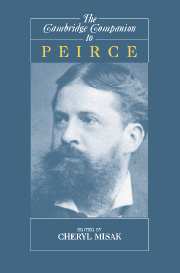Book contents
- Frontmatter
- 1 Charles Sanders Peirce (1839-1914)
- 2 Peirce's Place in Pragmatist Tradition
- 3 Peirce and Medieval Thought
- 4 Reflections on Inquiry and Truth Arising from Peirce's Method for the Fixation of Belief
- 5 Truth, Reality, and Convergence
- 6 C. S. Peirce on Vital Matters
- 7 Peirce's Common Sense Marriage of Religion and Science
- 8 Peirce's Pragmatic account of Perception
- 9 The Development of Peirce's Theory of Signs
- 10 Peirce's Semeiotic Model of the Mind
- 11 Beware of Syllogism
- 12 Peirce's deductive Logic
- Note on References
- Bibliography
- Index
9 - The Development of Peirce's Theory of Signs
Published online by Cambridge University Press: 28 May 2006
- Frontmatter
- 1 Charles Sanders Peirce (1839-1914)
- 2 Peirce's Place in Pragmatist Tradition
- 3 Peirce and Medieval Thought
- 4 Reflections on Inquiry and Truth Arising from Peirce's Method for the Fixation of Belief
- 5 Truth, Reality, and Convergence
- 6 C. S. Peirce on Vital Matters
- 7 Peirce's Common Sense Marriage of Religion and Science
- 8 Peirce's Pragmatic account of Perception
- 9 The Development of Peirce's Theory of Signs
- 10 Peirce's Semeiotic Model of the Mind
- 11 Beware of Syllogism
- 12 Peirce's deductive Logic
- Note on References
- Bibliography
- Index
Summary
Early and late, Peirce analyzed thought as a process of signproduction and sign-interpretation. But his early doctrine of “thought-signs” was deeply flawed and, therefore, he revised it drastically, changing its basic principles and greatly extending its scope. As he did that in several stages over many years - often in letters or unfinished manuscripts - what we now possess is little more than a sequence of contradictions, a series of ambitious yet unfinished sketches of elaborate but mutually incompatible structures. And yet, Peirce's work on signs cannot be ignored; for his pragmatic theory of inquiry and his synechistic account of the mind are incomplete without it. This essay traces the development of Peirce's theory of signs, or semeiotic, culminating in the mature, or post-1906, version of that theory. To speak of this mature theory at all is to speak hypothetically: it has to be constructed from the surviving manuscripts of Peirce's last years plus all that is consistent with them from his earlier writings.
- Type
- Chapter
- Information
- The Cambridge Companion to Peirce , pp. 214 - 240Publisher: Cambridge University PressPrint publication year: 2004
Accessibility information
- 42
- Cited by

